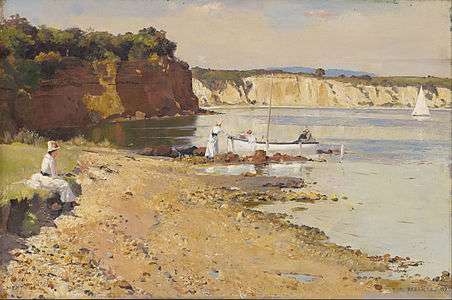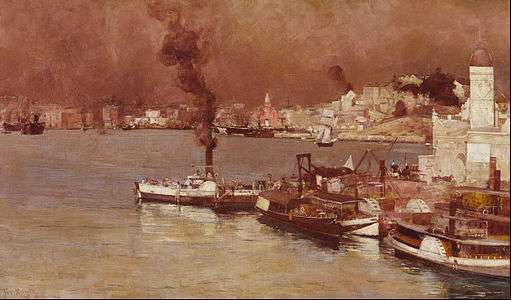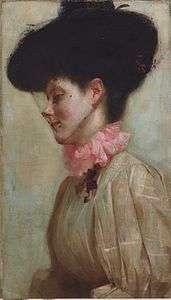Tom Roberts
| Tom Roberts | |
|---|---|
.jpg) Roberts, c. 1895 | |
| Born |
8 March 1856 Dorchester, Dorset, England |
| Died |
14 September 1931 (aged 75) Kallista, Victoria, Australia |
| Resting place | Illawarra churchyard, near Longford, Tasmania |
| Other names | Nickname Bulldog |
| Occupation | Artist |
| Spouse(s) |
Elizabeth (Lillie) Williamson (m. 1896–1928) Jean Boyes (m. 1928–31) |
| Parent(s) | (Father) Richard Roberts (Mother) Matilda |
Thomas William "Tom" Roberts (8 March 1856 – 14 September 1931) was an Australian artist and a key member of the Heidelberg School, also known as Australian Impressionism. After attending art schools in Melbourne, he left for Europe in 1881 to further his training, and returned home in 1885, "primed with whatever was the latest in art".[1] He did much to promote en plein air painting and encouraged other artists to capture the national life of Australia. While he is best known for his "national narratives", among them Shearing the Rams (1890), A break away! (1891) and Bailed Up (1895), he also achieved renown as a portraitist.
Life

Roberts was born in Dorchester, Dorset, England, although some mystery surrounds his actual birthdate: his birth certificate says 8 March 1856, whereas his tombstone is inscribed 9 March.[2] He migrated with his family to Australia in 1869 to live with relatives. Settling in Collingwood, a suburb of Melbourne, Victoria, he worked as a photographer's assistant through the 1870s while studying art at night under Louis Buvelot and befriending others who were to become prominent artists, notably Frederick McCubbin. He returned to England for three years of full-time art study at the Royal Academy Schools from 1881 to 1884. He traveled in Spain in 1883 with Australian artist John Peter Russell, where he met Spanish artists Laureano Barrau and Ramon Casas who introduced him to the principles of Impressionism and plein air painting.[2] While in London and Paris, he took in the progressing influence of painters Jules Bastien-Lepage and James Abbott McNeill Whistler.[2]
Through the 1880s and 1890s Roberts worked in Victoria, in his studio at the famous studio complex of Grosvenor Chambers at 9 Collins Street, Melbourne. In 1885 he started painting and sketching excursions to outer suburbs, creating camps at Box Hill and Heidelberg, where he worked alongside McCubbin, Arthur Streeton and Charles Conder, working on representing Australia’s light, heat, space and distance.[2]
In 1896 he married 35-year-old Elizabeth (Lillie) Williamson and they had a son, Caleb. Many of his most famous paintings come from this period. Roberts was an expert maker of picture frames, and during the period 1903–1914, when he painted relatively little, much of his income apparently came from this work. Roberts spent World War I in England assisting at a hospital. In Australia, he built a house at Kallista, near Melbourne. Elizabeth died in January 1928, and Roberts remarried, to Jean Boyes, in August 1928. He died in 1931 of cancer in Kallista near Melbourne. He is buried near Longford, Tasmania.
Work

Roberts painted a considerable number of fine oil landscapes and portraits, some painted at artist camps with his friend McCubbin. Perhaps the most famous in his time were two large paintings, Shearing the Rams, now displayed in the National Gallery of Victoria and The Big Picture, displayed in Parliament House, Canberra. The Big Picture, a depiction of the first sitting of the Parliament of Australia, was an enormous work, notable for the event depicted as well as the quality of Roberts' work.
Shearing the Rams was based on a visit to a sheep station at Brocklesby in southern New South Wales, depicted the wool industry that had been Australia's first export industry and a staple of rural life. At the time it was exhibited, it was criticized because many critics did not feel that it fitted the definition of 'high art'. However, since the wool industry was Australia's greatest export industry at the time, it was a theme with which many Australian people could identify and shows Roberts putting his training to work translating "the classical statuary into the brawny workers of the shearing shed".[3] Shearing would probably have been much messier than shown in the image, although shearing rules at the time did expect the sheep to be carried as shown in the picture.[4]
Roberts made many other paintings showing country people working, with a similar image of the shearing sheds in The Golden Fleece (1894),[5] a drover racing after sheep breaking away from the flock in A break away!, and with men chopping trees in Wood splitters (1886). Many of Roberts' paintings were landscapes or ideas done on small canvases that he did very quickly, such as his show at the famous 9 by 5 Impression Exhibition in Melbourne, "9 by 5" referring to the size in inches of the cigar box lids on which most of the paintings were done. Roberts had more works on display in this exhibition than anyone else.
In 1888 Roberts met Conder in Sydney and they painted together at Coogee beach. The younger Conder found these painting expeditions influential and decided to follow Roberts to Melbourne later that year to join him and Streeton at their artists’ camp at Heidelberg. While Conder painted Coogee Bay emphasising on the decorative qualities of form and colour, Roberts’ Holiday sketch at Coogee(1888) embodies his primary focus on the landscape’s natural effects.[6] It is an early testament to Roberts’ plein-air ‘impressionist’ technique, which brought out the sun’s glare on the bright blue sea, bleached white sand, dry grass and spindly seaside vegetation.
Legacy
Roberts' life was dramatised in the 1985 mini series One Summer Again.
Retrospectives
A retrospective toured Australia in 1996-97 and another was shown at the National Gallery of Australia from December 2015 - March 2016.[3][7]
Gallery
- Tom Roberts's works
 Bourke Street, 1886, National Gallery of Australia
Bourke Street, 1886, National Gallery of Australia Coming South, 1886, National Gallery of Victoria
Coming South, 1886, National Gallery of Victoria Slumbering Sea, Mentone, 1887, National Gallery of Victoria
Slumbering Sea, Mentone, 1887, National Gallery of Victoria A break away!, 1891, Art Gallery of South Australia
A break away!, 1891, Art Gallery of South Australia Bailed Up, 1895, Art Gallery of New South Wales
Bailed Up, 1895, Art Gallery of New South Wales An autumn morning, Milson's Point, Sydney, 1888, Art Gallery of New South Wales
An autumn morning, Milson's Point, Sydney, 1888, Art Gallery of New South Wales Portrait of Florence, 1898, Art Gallery of New South Wales
Portrait of Florence, 1898, Art Gallery of New South Wales The Camp, Sirius Cove, 1899, Art Gallery of New South Wales
The Camp, Sirius Cove, 1899, Art Gallery of New South Wales
See also
References
- ↑ Diggins, Lauraine. The Australian Impressionists. Melbourne: Lauraine Diggins Fine Art, 1988. ISBN 0959274340, back cover
- 1 2 3 4 "Tom Roberts". AGNSW collection record. Art Gallery of New South Wales. Retrieved 6 April 2016.
- 1 2 McDonald, John (12 December 2015). "Review: John McDonald on Tom Roberts at the National Gallery of Australia, a break-away star". The Sydney Morning Herald. Retrieved 13 December 2015.
- ↑ "The Shearing Dispute".
- ↑ Roberts, Tom (1894). "The Golden Fleece". AGNSW collection record. Art Gallery of New South Wales. Retrieved 6 April 2016.
- ↑ Roberts, Tom (1888). "Holiday sketch at Coogee". AGNSW collection record. Art Gallery of New South Wales. Retrieved 6 April 2016.
- ↑ "Tom Roberts". National Gallery of Australia. Retrieved 13 December 2015.
Further reading
- Croll, T.H. (1946) Smike to Bulldog : letters from Sir Arthur Streeton to Tom Roberts, Sydney, Ure Smith, (Sydney: Waite and Bull)
- Pearce, Barry (2000) Australian art in the Art Gallery of New South Wales, Art Gallery of New South Wales, Sydney, ISBN 0734763093
- Topliss, Helen. "Roberts, Thomas William (Tom) (1856–1931)". Australian Dictionary of Biography. Australian National University. Retrieved 5 June 2007.
- Topliss, Helen (1985). A Catalolgue Raisonne Volumes I and II. Oxford University Press, USA. p. 544. ISBN 0-19-554513-3.
External links
| Wikimedia Commons has media related to Tom Roberts. |
- Tom Roberts on Picture Australia
- Tom Roberts at the Art Gallery of New South Wales
- Tom Roberts on artistsfootsteps.com
- Tom Roberts at the National Gallery of Victoria
